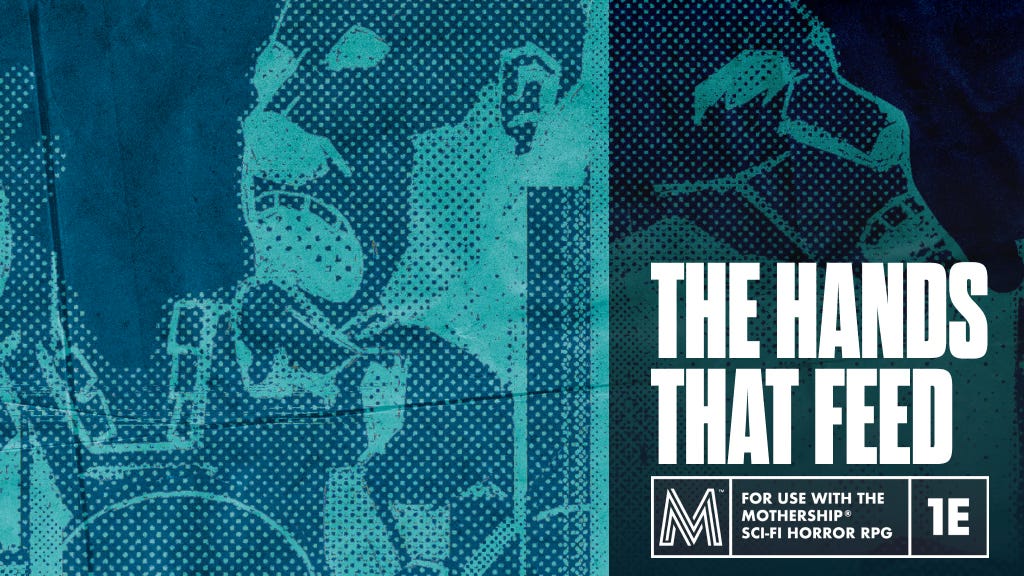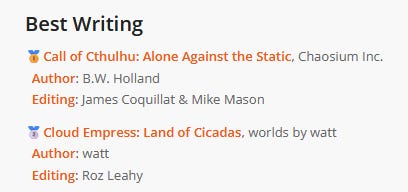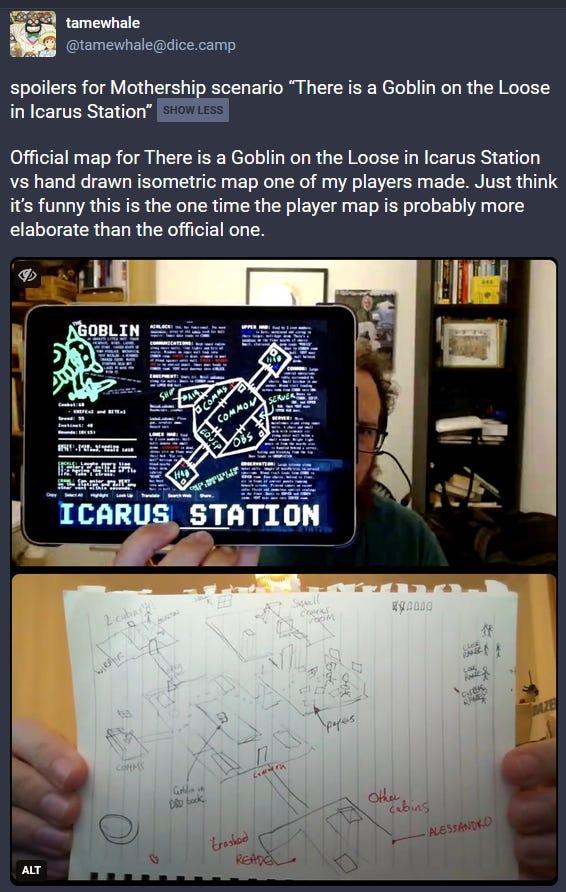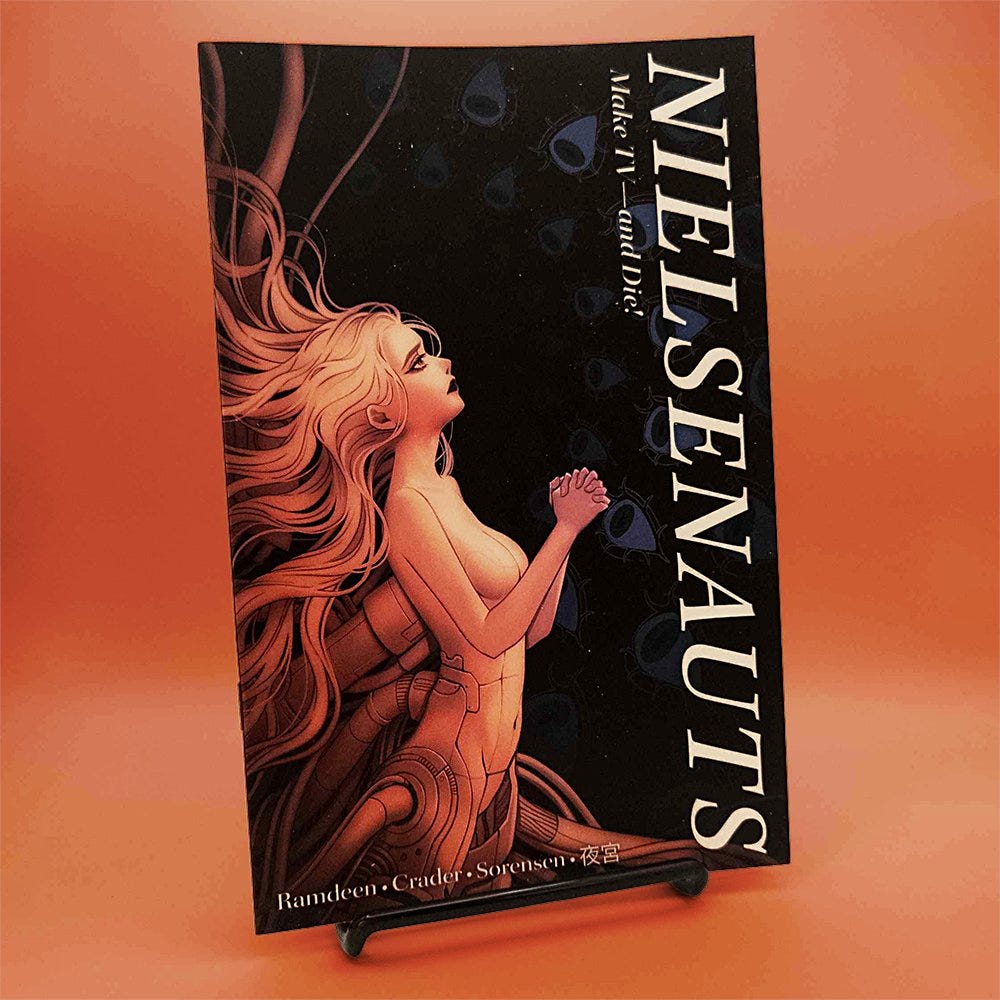This Missive is already overdue and I’m happy with this month’s freebie given my available free time this month (but it took more time than originally planned) so the thoughts here are not quite fully developed (maybe I’ll expand upon them later with examples from my own work), but still, I hope this gets you considering some things you may not have before now.
I have been reading a lot of fiction this year. Outside of TTRPGs, I’d hardly read anything over the last several years so I set a reading goal for 2024 of 8 books back in January, a small goal but one that I still felt I could easily fall short of given the last few years. As of this writing, I’ve finished 18 book so far. Due to this massive influx of mostly-good fiction in my life, I’ve been thinking more about the role fiction can play within TTRPGs (and how it feels often overlooked or intentionally left out of many indie projects).
I am a pretty staunch supporter of the idea that the TTRPG book, the thing I make and the thing we buy, is not the game. It is a book. The game is the thing that happens at the table, that unique blend of every player’s interpretations and choices which may have been in no small part inspired by the book but are in no way beholden to it. Because of this, it is reasonable (I think) to consider the role of every TTRPG book in inspiring play. Strong mechanics and well-written scenarios mean little if they never hit the table, if the game is never truly born, so a truly great TTRPG book is one that inspires play as much as (if not more than) it uses smart design to ensure (as much as it can) that play is captivating, fun, and rewarding.
Most commonly, TTRPGs inspire play with art. While art often aligns with good marketing (in so much that people like to pay money for pretty and cool looking things), good art quickly and dramatically inspires play. A single page of art can quickly communicate the vibe of a world, the type of situations that arise within it, the choices and abilities of its characters, and more. When I see all of that in a novel style/setting, it inspires play. It makes me want to create that type of situation at my table using the game, even though we may never recreate that exact moment and we certainly won’t create art on the same caliber for it even if it does. Beyond that, the art has nothing to do with the mechanical aspects of the game. Simply put, I do not need art to play the game—but how much more likely am I to play the game because the art is there?
I believe good game fiction can serve a similar role, but too often, we as designers—in pulling away from the massive hardback tomes of more traditional games, overflowing with words (most of them unneeded or unwanted)—cut out the entirety of a thing without examining its purpose more closely before we do so. We pull back so harshly from the boring 50+ pages of encyclopedic worldbuilding at the front of a 5e sourcebook that we miss the idea of a five-page short story or a two-paragraph piece of flash fiction. A good piece of properly-scoped fiction can communicate all of the same things a wonderful art spread can: the feeling of the world, the types of characters inhabiting this world, the situations characters face and their abilities to effect the world around them. Interesting situations, character choices and consequences can all be explored in just a few paragraphs. Additionally, writing can inspire actionable aspects of the game as well - things that the GM use or can aim to replicate, if they are so inspired: mostly, narrative voice and evocative descriptions. Because roleplaying is often just a story we are telling one another, having stories within the text can be quite helpful, especially for the aspiring GM.
In all of my reading this year, fiction—totally devoid of rules, mechanics, random tables, etc.—has regularly inspired my play (plus my writing, my further reading, etc., etc.)! And yet many games have totally excised this aspect of the traditional TTRPG book which I think is often a shame. I imagine there is a middle ground to discover.
Of course, now you will say “Okay, but if you think this then where is this kind of fiction within your own projects?” and you are right to do so! In short, I have until now very much been a “I don’t need that in my games!” type of designer. Now though, I am working on adding fiction to the scope of Tacticians of Ahm (likely a short story at the opening of the world almanac and smaller pieces within the core rulebook, where I think it will have the most impact out of any of my current projects), and I’m looking to incorporate shorter fiction (1-2 pages at a book’s opening and/or even lots of smaller bursts of “flavor text” throughout) into my upcoming adventures.
It may have taken me reading far more books this year than I expected myself to to re-discover this, but good fiction of an appropriate size and scope can greatly inspire play, just as much as evocative art, and we, as designers and especially as writers, would be foolish to overlook its place within our projects.
UPCOMING PROJECTS
I wrote an adventure for The Hands That Feed, Spicy Tuna RPG’s latest Mothership book! It’s an anthology of corporations, created by a number of awesome designers like Joel Hines and Diogo Nogueira, along with powder keg missions (like mine) where several of the corporations face off in an interesting location with the player character stuck in the middle. It’s launching soon on Kickstarter, and you can follow it here!
My adventure features one of my favorite creatures I’ve cooked up for Mothership so far: The Phyrixian Sage—a Prometheus-inspired, long dormant, and immensely powerful xeno on a mission of its own, sending it across a region overrun with three corps all vying for control.
FREEBIE: Party Development Procedure
In the Quinns Quest review of Mothership, Quinns made a great point when he said:
Where in almost every respect Mothership feels blindingly modern, there is one area where I think it feels actually regressive… Mothership understands that one of the tasks it has to succeed at ,and it does succeed at this, is to capture the kind of practical jeopardy that you are in. It has the critical hit tables. It has stress. It has your financial worries, but it has nothing—NADA—to help create or catalyze the emotional stakes to make you feel like your character sheet is more than an island. For example, to make you feel like you're one half of a relationship or part of a whole team that stands for something bigger than the fact that you all just spawned into the same level together.
All good criticisms are, if nothing else, wonderful bits of inspiration to those looking to hack and homebrew the game they love. I took this comment to heart and thought about how I could add a streamlined bit of party development to Mothership in a way that felt true to the rest of the game’s design but also got the table collaborating on their own stories in the style of other games I enjoy.
What I ended up creating is the aptly named Party Development Procedure or PDP: Three d10 tables, each of which are rolled on in different ways, to help add additional stakes and context to your party and characters prior to play. In ten minutes or so, you should come away from this procedure knowing what kind of collective your party is, how you feel about each of the other PCs, and something you are hiding from the group (for better or worse). Once you start playing though, how all of these things shift and develop is, of course, up to the players.
Download the full quality files (including a printer friendly version) HERE!
MORE COOL STUFF
Cloud Empress: Land of Cicadas won a Silver ENNIE for Best Writing! I was so happy to see watt’s incredible writing and Roz Leahy’s always excellent editing getting appreciated on the biggest TTRPG award stage!
There is a Goblin on the Loose in Icarus Station and The Mole on PIRAD ONE have both hit Silver Seller status and ULTIMATE BADASS has hit Copper Seller status on DriveThruRPG! That puts them in the top 30% and 40% respectively of all products on DTRPG! I’ve been neglecting my DTRPG catalog for a while now, but I’m hoping to correct that a bit over the next month or two. Thanks for all the support!
HOME, a Mech x Kaiju mapmaking RPG by Nick Gralewicz, is out now! I edited this book (Nicks’ first TTRPG), and I think it is something really special. If you like mapmaking, collaborative storytelling, or Godzilla/Pacific Rim-style stories, you’ll love this. Check it out HERE!
As I mentioned earlier, Quinns Quest recently did a great review of Mothership, and it includes several nice shout-outs to some of the best third-party designers in the space right now!
On Mastadon, Tamewhale recently ran There is a Goblin on the Loose in Icarus Station with his group, and one of the players drew a vastly more detailed map than the one I drew in the module itself. It’s always great to see a creative, keen-eyed player like this at the table!
Sam Sorensen, one of my favorite people to talk TTRPG design/game theory nonsense with, put out his latest annual GenCon zine: Walls, Floors, and Doors! It’s a tightly designed little zine all about building a good dungeon from ten different dungeon pieces Sam has created. Cool and actionable!
I’ve been re-watching X-Files and some of the show’s best early episodes give some great guides to follow for mystery/horror adventure design! Here’s what I originally posted over on Twitter:
“I've been watching X-Files, and the thing it does that is a great reminder for anyone writing mystery/investigation TTRPG stuff is that there is The Truth and there is Someone Who Wants It to Be Hidden, often these two things are totally separate. That 3-way struggle is key.
The Truth is "There are Aliens" and the aliens may wish to be hidden, but also, you need another faction at play. The second force may be "The Air Force Wants It Hidden to Create Advanced Tech In Secret." The PCs are always fighting on two fronts. The knife can always twist.
And obviously, this doesn't have to just be a 3-way struggle. You can go more and more complex, but I think at its most basic structure, a good mystery or conspiracy needs the PC faction and 2 factions working against them (but often not working together).
A fun way to think about it: You are playing hide and seek. Your friend is hiding and you are seeking. Okay, that's fun enough but pretty mundane. Now, imagine a guy who is also playing who's entire job is just to make sure you don't find your friend. Now that's exciting!
And another bit from a following episode:
Another TTRPG Mystery/Investigation Thought (Inspired by The X-Files): Have at least one mundane threat that is just as dangerous (and possibly even more dangerous) than the supernatural/paranormal one.
Wait, the NSA is busting down doors looking for you and how you know what you know? Oh yea... the wraiths haunting the outskirts of town are pretty scary too.
Space Penguin Ink just released Nielsenauts by Chris Ramdeen, Jarret Crader, Sam Sorenson, and Yomiya. I’ll just let the game’s description sell itself here: “You are Nielsenauts, the artificial intelligence we’ve designed to create unscripted, budgetless entertainment in incredibly realistic CGI worlds. This groundbreaking process does away with actors, writers, and production crews, replacing them with disposable virtual workers, like yourselves! Thanks to this new form of tireless, free labor, profit margins now exceed anything in television history. So get to work, and work fast, as these next fifteen minutes will determine the rest of your lives—literally!”
If you have a subscription to Rascal News, this is a very good interview with Spencer Campbell and Will Jobst where Campbell discusses existing online as a designer, burn out, and moving away from TTRPGs. A lot of what he’s dealing with mirrors some of my own struggles I discussed in the last Missive.
Perplexing Ruins (in partnership with The Lost Bay Studio) recently released a print version of Gnome, his recent Tunnel Goons hack of gnomish adventure. I love the art throughout this book, and Tunnel Goons is a great, superlight framework to build a game of little guys doing interesting things on. Plus, it’s got solo play!
I’m still out and about exploring my new home. Summer in Newfoundland is a beautiful but fleeting time so I have been making my best effort to appreciate it as much as I can. Here are a drone video of the nearby Fort Amherst lighthouse and one of about 200+ shots I recently took during a boat tour to the Witless Bay Ecological Reserve.
Stay safe and have fun. - Christian














Great post. Big up to more thoughful fiction in game books. Moments of micro-fiction--even a subheader phrase, diegetic excerpts, or NPC quotes--help infuse a game with more character, and better inspire play.
The PDP is great. For how much baggage these three lil rolls could bring to a game, it's impressive how concise it is. Also, I hadn't considered it when I heard Quinn's review, but my first Mothership pamphlet pair, The Sleeper Crew, is also a party-galvanization tool, giving all the PCs a common goal and similar backgrounds. (Also weird mutation stuff because I guess that's what I always do, haha.)
Great insight on the book being inspirational and the game at the table being the sum of other factors. Maybe that’s why I have so many unplayed books: in fact they have been played because they inspired me on my tables somehow.